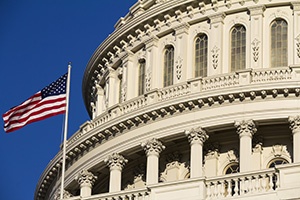 We’ve been talking all week about the economy, the markets, and the risks therein. But looking back on these posts, there seems to be a glaring hole: the government shutdown.
We’ve been talking all week about the economy, the markets, and the risks therein. But looking back on these posts, there seems to be a glaring hole: the government shutdown.
That absence wasn’t an accident. In the longer term, which is how investors should look at things, the current government shutdown very likely won’t matter. As such, it hasn’t warranted a discussion. The shutdown will last until it’s over. Then, we will move on, just as we have done with past shutdowns.
A lingering situation
Today, though, the current shutdown ties for the longest ever with the 1995–1996 shutdown under Bill Clinton. Now, as then, the issue is a confrontation between a president and Congress of different parties. I won’t get into the politics of the situation, as we all have our own opinions. But from an economic perspective, the shutdown is starting to change from a blip to a potential problem, which will grow more serious over time.
Up until now, the effect has largely been on confidence. No one likes a shutdown, and the uncertainty can rattle markets. At the same time, we have seen this before—twice last year—so markets were taking it in stride. The presumption was that a deal would be cut, and life would go on.
That still remains the base case. But the fact that we will be in record territory come tomorrow and that negotiations seem to have stalled means we have to consider what would happen if the shutdown extends for a much longer period.
The direct costs
An Office of Management and Budget analysis of the 2013 shutdown (lasting 16 days) estimated an impact of 0.2 percent to 0.6 percent on GDP, which is significant, as well as the loss of about 120,000 private-sector jobs. We are now in the 21st day of the shutdown. So, a reduction in GDP of somewhere between 0.5 percent and 1 percent and about 200,000 jobs might be a reasonable estimate of the current damage, which will continue to accrue over time. For an economy growing at a rate of about 2 percent to 2.5 percent, that loss is material. The direct impact is real and growing. If it ends quickly, it will be a blip. But as it extends, the damage is really adding up.
The indirect costs
Those are just the direct costs. The indirect costs include loss of consumer and business confidence, which drives spending and investment; damage from lack of services (e.g., a TSA slowdown at airports); and lost transactions (e.g., failed student loans, farm loans, and others under federal programs). Again, these costs are manageable in the short term but will mount over time.
More trouble ahead?
Making the shutdown even more worrying is that once we get beyond it, we have another financial and political battle pending: the U.S. hits the debt ceiling likely sometime this summer. The last Congress agreed to suspend the debt ceiling, which took it off the table. But that suspension expires on March 2. At that point, the Treasury will have to resort to the “usual emergency measures” to keep the government operating while Congress negotiates to increase the debt ceiling. This shutdown may just set the stage for an even more damaging confrontation later this spring.
Not a big deal, yet
A short shutdown has become normal and, as such, is not worth commenting on too much. This shutdown, however, is moving into new territory. As the direct damage mounts and the indirect consequences pile up, we can expect the effect on the economy and markets to get potentially much worse, all while setting the stage for the debt ceiling battle.
Pay attention. This wasn’t a big deal, but it could become one quite quickly.


 Print
Print

